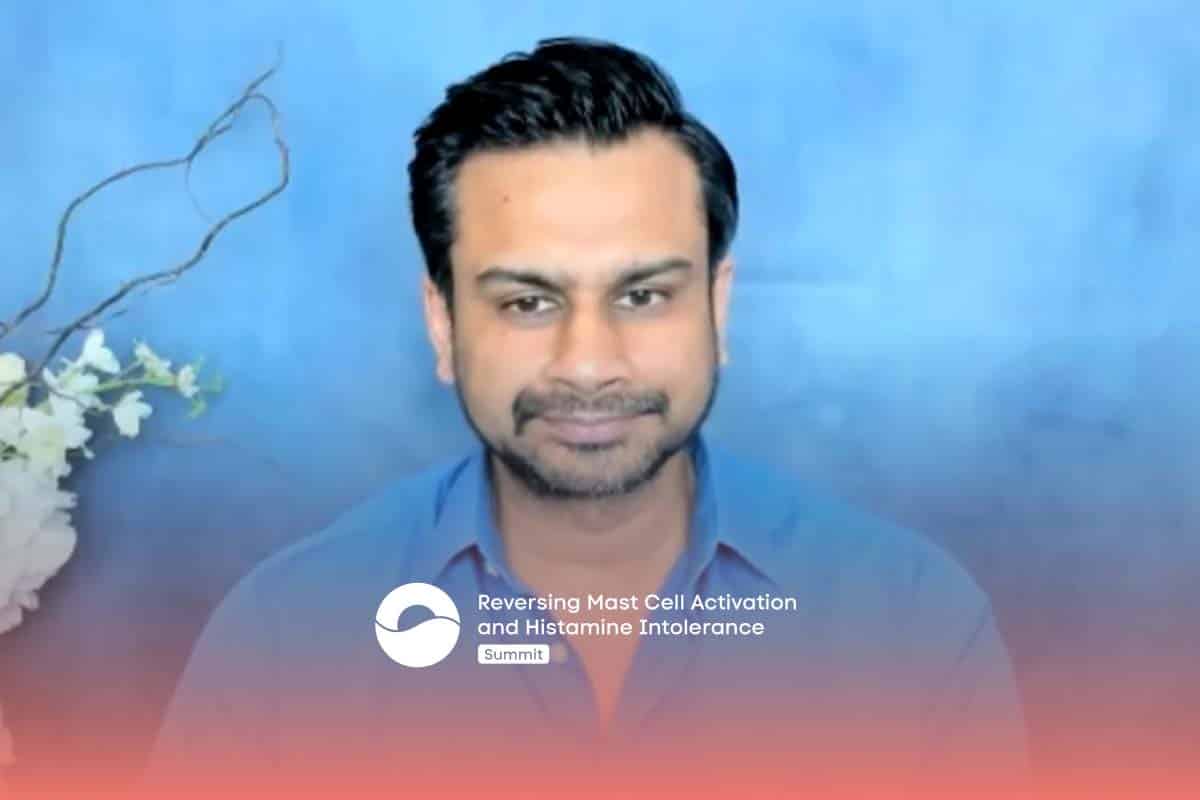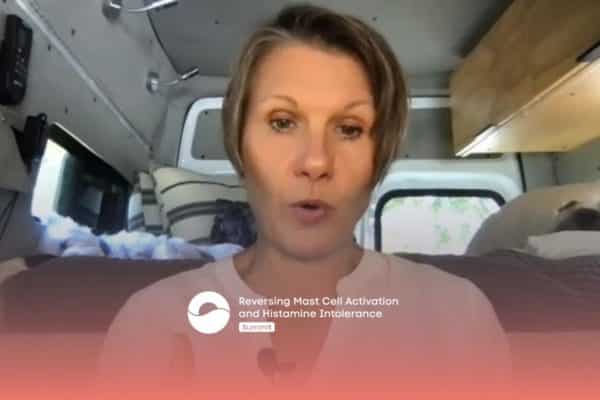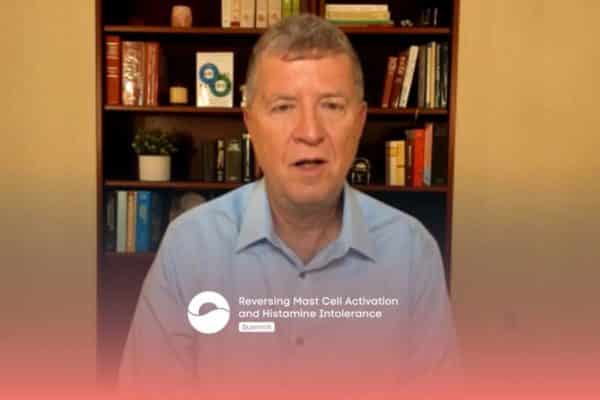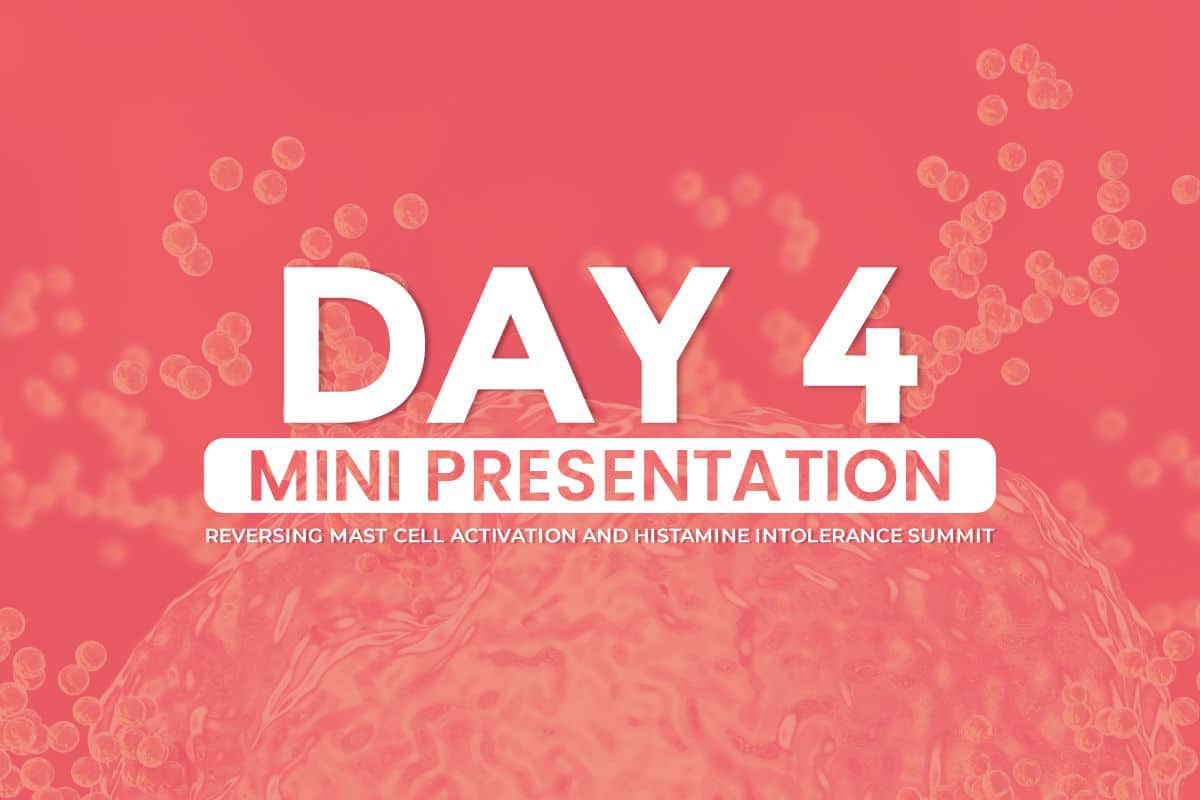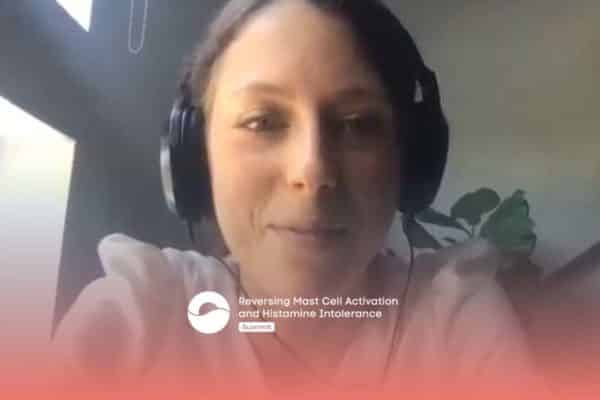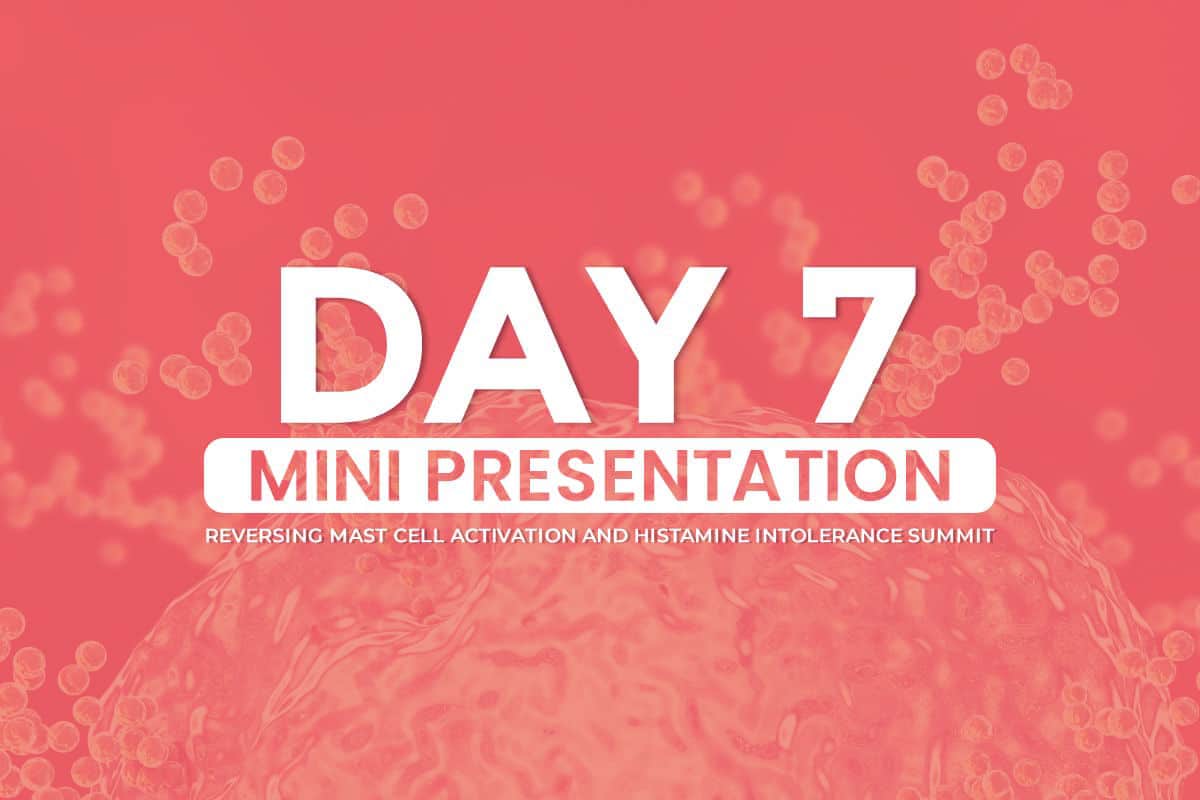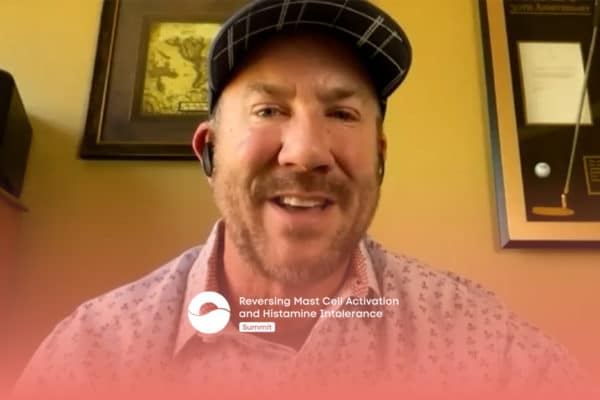Join the discussion below

Beth O’Hara is a Functional Naturopath, specializing in complex, chronic cases of Mast Cell Activation Syndrome, Histamine Intolerance, and Mold Toxicity. She is the founder and owner of Mast Cell 360, a Functional Naturopathy Practice designed to look at all factors surrounding health conditions – genetic, epigenetic, biochemical, physiological, environmental,... Read More

Ashok is an internationally renowned Speaker, Filmmaker & Health Practitioner who has dedicated his life to supporting people through chronic illness, and achieving their potential.Ashok suffered from ME, or Chronic Fatigue Syndrome, around 25 years ago when he was studying at Cambridge University. Through neurological research that he conducted, he... Read More
- Missing Keys in stubborn chronic illness
- Resetting sensitivities
- Rebooting in Long-Haulers
Related Topics
Abuse, Amygdala, Antidepressants, Background Inflammation, Brain, Brain Fog, Castle, Childhood Experiences, Chronic Conditions, Chronic Fatigue Syndrome, Chronic Illness, Cognitive Difficulties, COVID, Genetic Predisposition, Histamine, Immune Response, Immune System, Infections, Inflammation, Kingdom, Lyme Infection, Mast Cell Activation, Mcas, Me, Memory Loss, Mold Toxins, Nervous System, Neuroplasticity, Overtraining Syndrome, Pain, Pollutants, Sensitivities, Survival, Toxins, Trauma, Traumatic Event, VirusesBeth O’Hara, FN
Welcome back to the Reversing Mast Cell Activation and Histamine Intolerance Summit. I’m your host, Beth O’Hara of Mast Cell 360. And I’m so happy today. I have with us, my colleague and friend Ashok Gupta. We’ve been working together for a few years. And if you have been dealing with sensitivities, mast cell activation, where you feel stuck, mold toxicity, where you feel stuck, this is an interview you definitely wanna listen to because this is a huge piece of the pathway to getting unstuck. And what we’re gonna talk about is one of the cores of the MC 360 process that we use in our clinic at Mast Cell 360. Let me tell you a little bit about Ashok and then we’ll bring him on. So he’s a well-known neuroplasticity expert and health practitioner, and he has dedicated his life to supporting people through chronic illness and achieving their potential. And he suffered himself from chronic fatigue syndrome about 25 years ago, when he was studying at Cambridge. Through the neurological research he was conducting, he managed to get himself a hundred percent better. It’s really inspiring and exciting. And then he went on to set up the clinic to help others and published a lot of well-known neuroplasticity brain retraining program called the Gupta Program. And they’ve been doing ongoing research on the effectiveness of this program. And it’s now being used to support people with mast cell activation syndrome, mold toxicity, chronic fatigue, multiple chemical sensitivities, long COV!D, and a lot of other related conditions. Thank you so much for being here with us, Ashok.
Ashok Gupta, MSc
Thank you, Beth, for that wonderful introduction. Thank you.
Beth O’Hara, FN
And I know just like so many of us that have dedicated our lives to this, you have to have a passion for this, and that passion comes from usually our own stories. Can you share with us a little bit about what happened for you with your health and then how did that lead into the work that you’re doing today? ‘Cause I know you were pretty sick, just like so many of us.
Ashok Gupta, MSc
That’s right, Beth. As you say, many of us as practitioners came to this from our own experiences and feeling like that the mainstream medical profession wasn’t really catering to the huge amounts of suffering that occurs with these conditions and not prioritizing them. So, yeah, as you’ve mentioned, I was studying as an undergrad and, you know, living life to the full, had loads of energy, doing everything. And then I went to India and got a stomach bug, like most people who go to India do. And I came back and the stomach bug went, but my body never recovered. And I just went downhill. And I just got more and more fatigued, more and more symptoms would come to me, pain, cognitive difficulties, to the point at which I’d open up a textbook and I couldn’t even read it, like real amounts of brain fog, memory loss. In my worst days, I had to crawl to the bathroom. And it got so bad that I was almost, you know, suicidal.
And in that moment it was like a brick wall. You know, it’s like, what am I going to do with my life? And I would see doctor, to this doctor, that doctor. They say, “Oh, you’ve got depression. Here’s some antidepressants,” but that would make me feel worse. Or they would tell me that, “Look, you’ve got this condition called ME or chronic fatigue syndrome. We don’t know what causes it. We don’t know how to treat it. There’s no cure. You’re probably gonna have this forever. Go and rest.” And I thought, you know, what am I supposed to do with that information? And for me, I’m someone who can’t take no for an answer. And I said, no, this is not good enough. There has to be some reasoning behind this. So I made a promise to the universe. I said, “If I can figure this out, if I can just work out why I’m ill, if I can get myself better, there’s thousands, millions of people who are suffering… If I can get myself better, I will dedicate the rest of my life to helping others with this condition.”
And so I, as you said, studied lots of brain neurology, especially the work of Professor Joseph LeDoux on the amygdala, part of the brain, worked out a hypothesis as to what was going on, then ad hoc, retrained my brain on the periphery of consciousness, got myself a hundred percent better and then set up a clinic to treat others and then published a medical paper online in 1999 and in Medical Hypotheses journal in 2002. And since then we’ve been treating patients, learning about what works. So we didn’t say, “Right, we figured it out.” We try to be as humble as possible, and say, “What’s really helping people?” And then in 2007, we were the first brain retraining neuroplasticity program to publish our treatments.
Beth O’Hara, FN
And one, I’m so happy that you’ve gotten better, and so sorry that you had those experiences, and I have my own health journey and similar thing really, fell apart in college. Your work has been quite instrumental in the hundreds and hundreds of people that have come through our clinic and also our wider community and a wider audience. And I wanna talk about what’s behind that so that people can understand why this is so important. And probably a good place to start is just what is the limbic system, the amygdala that you’re mentioning, part of the limbic system, what does it govern? What is it managing for us? And then how does it get dysregulated when we have these kinds of chronic conditions?
Ashok Gupta, MSc
Yes, it’s such a mystery, isn’t it, Beth? Like, it’s something when it happens and you go from doctor to doctor and they don’t have an explanation that seems reasonable. It’s like, what is this mystery? And I’d love to start from first principles. You know, I always ask this big question: Why are we here? Right? Because there has to be a logical reason for these conditions, like mast cell activation. And I want everyone to think about, from a scientific perspective, we’re here because our brain, our nervous system, this physical body is designed to protect us against the environment, ensure survival so that we can pass on our genes to the next generation. So we are survival machines. And our mast cell cells are part of that survival process. They get activated when we have threats, toxins in the body, viruses, infections, et cetera. And what really happens is that when we go through a traumatic event, and normally we think of trauma as emotional trauma, but imagine that when you have a virus, and let’s take the example of long COV!D as an example, right? So let’s take the example of COV!D-19 infection. When you’re exposed to COV!D-19, your body knows that that is life threatening, just like any infection is. And so it recruits all your defenses. And let’s take a really good example here of, Beth, I don’t know, are you a fan of “Game Of Thrones”?
Beth O’Hara, FN
I did watch it, though it was not good for my limbic system-
Ashok Gupta, MSc
Yes.
Beth O’Hara, FN
But I did watch it.
Ashok Gupta, MSc
Well, yes. No, very good point. Although, let’s take the example of a fairy tale, right? And, Beth, imagine you’re the queen of the castle. Yep. And your navy is the immune system and your army is the nervous system. And the nervous system and the immune system are there to protect the castle and the kingdom, and you are the queen of the kingdom. And along comes an invader, in this case, COV!D-19 infection. Now, the army normally can fight off that infection very easily. Like many people have COV!D-19 and they hardly have any symptoms and off goes to the invading army, and everything’s fine. But imagine that, for whatever reason, there’s a drought in the kingdom, which is analogous to many people feeling overstretched, overworked, could be chronic stress, could be even athlete’s overtraining syndrome. It could be pushing your body too hard, whatever it is, your system’s not quite at its stable level.
Beth O’Hara, FN
All right, you can think about these like underlying mold toxins people have accumulated, but they’re functioning, or underlying Lyme infection, but then maybe they’re not symptomatic.
Ashok Gupta, MSc
Exactly right. So it could be an underlying background inflammation. I mean, we know in the modern era, because we are surrounded by pollutants, toxins, mold, our bodies are just in the background triggering slight bits of continual inflammation, yeah, which can, as you say, make our bodies even more prone to feeling overwhelmed when a real, you know, a more intense trigger comes along. And so there’s a drought in the castle, in the kingdom. And so the army and navy are weaker than they would be normally. Now along comes another invader over the hill. This is the COV!D-19 infection. And the army and navy work really hard to fight off this infection and they have to really recruit all the resources of the castle and they manage to just fight off the virus, just fight off the invading army. But now the army and navy are traumatized, because they realize, “Hey, we only just survived that experience.
What happens if another army comes over the hill? What happens if we didn’t defeat them and they’re just over the hill and we can’t see them right now?” And they come to you. So the generals of the army and navy come to you, Beth, the queen of the castle and they say, “Beth, we need all the resources of the kingdom. We need all the metal, all the wheat, all the energy,” yep, “so that we can be in a state of high alert and readiness, ’cause we want to protect the kingdom.” And so even though the original invaders have been fought off, it’s left its legacy of a traumatized immune system and nervous system that keep responding in a state of readiness using up all the resources of the castle. Now imagine that the army and navy, especially the navy, the immune system keeps firing off lots of arrows in random directions, just in case there could be an invader hiding over here or hiding over there. And actually it’s just a child playing with a stick in the garden. But the brain says that could be evidence of the army being present, quick, mast cell activation, histamine, and all the other chemicals go out to create this chorus of defensive responses.
And there we get a clue to MCAS and similar conditions of what’s occurring. It is our brain’s natural evolutionary correct thing to do to overprotect us, because our brains care more about survival than they do our wellbeing. That is the fundamental point, more about survival. And so as long as you survive and you err on the side of caution, you will procreate, pass on your genes the next generation. Now, if you are unwell, the brain doesn’t care so much about that. So then we generally find that there are triggers such as, firstly, genetic triggers, so we could have a genetic predisposition to these conditions that can be a lack of detoxification skills or that could be childhood experiences. So we know that people are more likely to get these conditions if they have adverse childhood experiences, abuse and trauma is the background. So that’s one risk factor.
Second risk factor is then this acute or chronic stress. And the third factor is this trigger. And if I can just show a little diagram that makes it a little more visual for people, you can see here that here are these kind of predisposing factors to getting these types of conditions such as long COV!D or MCAS. Predisposing factors: acute or chronic stress, and then a viral, bacterial are the trigger. And that can be mold. It can be a chemical. It can be COV!D-19. It can be a host of different things. Normally, the body deals with it, but in a minority of cases, it creates this trauma in the brain, specifically, the amygdala and insula, and I’ll come onto describing those two brain structures in a moment. And this course is this vicious cycle, where we have a trauma at the brain at number four, this causes chronic sympathetic arousal.
That means our stress system gets overtriggered. Our immune system gets overtriggered with all those mast cells getting activated now, which causes the symptoms at number six. So muscle dysfunction and pain, cognitive difficulties, those symptoms of allergic responses, sleep issues, autonomic dysfunction, a whole list of different symptoms, which then loop back to a hypersensitive brain at number eight and number nine, where the brain takes in all this incoming signals and says, “Aha, this is evidence of ongoing invasion, ongoing challenges in the body. Let’s retrigger the immune system and nervous system.” And around and around we go in these conditions. And you’ll even see it in number seven, that can lead to adrenal exhaustion. That can lead to mitochondrial dysfunction. So there’s this idea of cell danger response, where the cells actually themselves are in an altered state, not giving us the energy, because they’re in a defensive state. Latent virus and bacterial reactivations. And of course, as you’ve mentioned, allergies and sensitivities increasing in general, mainly because the whole body is in a defensive mode and any new supplement or chemical or medicine or food, it errs on the side of caution and starts firing off, just like the army firing off random arrows in different directions.
So in a nutshell, this is our hypothesis, that our brain has now gone into this altered state. It’s not in homeostasis anymore, not in balance. And the purpose of our brain retraining is to retrain and interrupt this vicious cycle. And finally many people and other programs that came later have used this idea of limbic retraining. In fact, that’s half the story, because the limbic system is the ancient part of the brain that mammals have. All mammals have a limbic system. Yeah. And that’s where the amygdala, the hippocampus, and the hypothalamus, they all sit in the limbic part of the brain. But the insula part of the brain, that sits between the limbic system and the cortex. That’s not actually part of the limbic system. And I believe that in the insula, that’s where the core trauma actually occurs. Now, I just wanna describe this insula part of the brain, ’cause this is very relevant to mast cell activation. So the insula is a part of the brain that takes in all incoming information from the body.
So that’s all how your body’s functioning, your heart rate, your blood pressure, your immune system, and takes that incoming information, processes it, and then creates the appropriate autonomic or immune response. Now, before, it used to be thought that our immune system was very peripheral. So some cells over here will detect an invader and create the appropriate response locally. But, of course, it makes sense that like you are the queen of the castle, you need all the generals all around the country to report back to you so you can make an integrated decision now to protect your castle. And it turns out that that integrated center is actually the insula. And some recent research, we’ve been following this for many decades, but some recent research has shown that when it comes to gut inflammation, they looked at gut inflammation in mice and they detected this specific signature in the insula part of the brain. And then they were able to trigger that part of the brain, the insula and create that same inflammatory response in the bowels. And that was groundbreaking research. No one’s ever done that on the planet before, that we know of. And it proves that, certainly, in animals, the insula is where we store that central information about how the body responds to our environment. So we believe that a mast cell activation is due to the insula and amygdala part of the brain learning to become overcautious, continually triggering these mast cell cells, which causes all these downstream symptoms and contributes to a wide variety of different conditions.
Beth O’Hara, FN
And that’s a great analogy. And what I wanna highlight for people, who this might mean new information for them, and we’ve talked about in other parts of our summit is that the mast cells line every nerve ending. They line every nerve sheath and there are mast cells, it used to be thought there were no mast cells in the brain. We now know their mast cells in the limbic system itself. And they’re responding to not just pathogens, the chemicals, every molecule of air they’re sensing; just like the nervous system, they’re responding to our thoughts, our stresses, our experiences, and they can respond within fractions of seconds. And it’s because of this interwoveness with the nervous system. I know when I did all my education, we had nervous system, we had immune system, psychology over on a different campus, but that’s not how we function. And we have to remember that the mast cells are this interface between the nervous system and the rest of the body. And that’s how all this is happening, that you’re describing, and why this nervous system angle is so critical.
And this is why I say that nervous system recovery and nervous system retraining is at least 50% of our healing process with mast cell activation is quite significant. So you talked about, and I’m on a high level with this hypervigilance when there’s the child playing with the stick in the garden but the army and the navy are traumatized. They don’t know, so they’re just kind of going in everything I say. They start shooting at the butterflies and they lose their fine tuning. They can’t tell anymore. And we’re not talking about, I mean, this certainly happens in people who are, for example, war veterans and have PTSD, but we’re talking about this in terms of having had a, we’ve crossed this threshold of the number of pathogens, chemicals, could be physical stressors, could be emotional stressors that we can keep up with, and that’s that cell danger response you’re talking about. And there’s this whole downstream effect.
But what I love and find so fascinating about the nervous system side of this is that we can use the nervous system work to send signals down to that cellular level to tell the cells we’re moving out of danger and into safety. That’s how I think about it and helping us to shift out of that cell danger response one. And we have whole topics just on the cell danger response for people so that they can get more deeper in that. Can you talk about that more? How we shift out cell danger response with this work? What’s happening and how are we using it to reprogram, particularly sensitivities? ‘Cause we get people who, they’re down to two foods, they can’t take any medications. They’re not tolerating supplements. I used to have to hold my breath going down the laundry detergent aisle. And if somebody was in the elevator, I couldn’t get in because they might be wearing cologne or I couldn’t get in a taxi, before we had Uber and Lyft, because there might be one of those tree things hanging, those air fresher thing-
Ashok Gupta, MSc
Oh, yeah. The air fresheners. Yes. Yeah. When people have this type of response as you’ve described, the first thing to realize is it’s perfectly normal and it doesn’t feel like it’s normal, but as far as the brain’s concerned, it’s doing the right thing. And so going back to our analogy, when those generals now have a meeting with Queen Beth, it is Queen Beth’s job, and that’s what we do in brain retraining, to say to these generals, “You guys have done a great job. You’ve done a valiant job, but the war is over.” Yep. “We have defeated the army. And actually by you continually thinking the army is here, you’re causing more issues now.” Yeah. “So we’d like you to calm down and feel safe.” And, you know, actually it’s equivalent of in an emotional situation. If you had a son or daughter or niece or nephew, and they were crying over something very small, what would you do?
You’d soothe them and say, “There, there. It feels really bad, doesn’t it? But actually it’s not that bad, you know.” And you would soothe and calm them down. And as similarly, we are soothing and calming down these defensive responses. And these defensive responses in the brain, as you say, traditionally, we separate them out. Emotional response, biological response, physiological response, endocrinological response, And these are different departments in hospitals, but the brain doesn’t see it that way. Originally, the amygdala was associated with PTSD and anxiety, fight or flight, but now it’s being associated with pain gateway, with immune system responses. So the brain doesn’t differentiate. It simply says, what do I need to do to survive? And so if there is a potential threat, it will create an emotional response, a physiological response, an immune response. And we can take advantage of that and be able to train the entire brain system so that we can indirectly calm down the immune response. And so you’ve described it exactly right there that we are going upstream. So rather than, you know, we give you the analogy of, imagine you’re standing on a bridge and you’re looking down and there’s people drowning in the river. So you jump in the river and pull them out. And then there’s another person who’s in the river, so you jump in and you pull them out. And suddenly there’s 60 people in the river and loads of people saving them. So they set up a hospital next to that bridge saying, “Right, we’re gonna fish all these people out and save them.” But one’s asking the question: Who’s throwing these people upstream into the river in the first place, right?
And so the cell danger response, exactly right, is the downstream effects, but it’s not really where the core programming lies. And I know there are certain theories around cell danger and how it’s localized. We just don’t buy into that. We believe truly that it is an upstream issue and those downstream cells are getting continual messages to be in that protective state. And of course it’s an interaction, so the brain’s constantly communicating with the body, the body is giving signals back to the brain. So it’s a chicken and egg. But ultimately if you can get to the core parts of the brain and calm and tamper down that response, the rest of the body begins to heal. And we’ve had something, you know, obviously some people need that extra support, but other people have been able to completely reverse their mast cell just through brain retraining, you know, and to come off all their supplements and they’re fine because they’ve gone to the root cause and others, they may need that, obviously that extra great support that people, like yourselves, provide.
So it’s really that hope, that realization that mainstream medicine has found it difficult to treat these types of conditions because they’re in that black box called the brain. So medicine is about measurement. What can we measure? We can measure hormones. We can measure enzyme. We can measure gut responses. But open this brain and try and figure out a hundred billion neurons, it’s impossible. So these types of functional conditions have got missed and they have become misdiagnosed, mistreated, because it’s very difficult to treat the brain in this way. And so until we’re able to dissect every single of the hundred billion neurons and figure out which one to retrain, until then we have these types of brain retraining neuroplasticity approaches to retrain the army and the navy essentially.
Beth O’Hara, FN
I think I like that approach better than trying to dissect all my neurons, but-
Ashok Gupta, MSc
Yeah, exactly.
Beth O’Hara, FN
That we’re on the same page in terms of we have to trace back to what are the top level issues here. And I love that you all have people who are able to do this just with the limbic retraining, and that’s amazing. This is where I have people start. And then if they are still struggling, whether we have to take the other threats out, I find that people can really struggle if they’re still exposed to mold toxicity, because we’re trying to retrain, but they’re in a lot of mold and that olfactory nerve keeps sending that dangerous signal. Another thing I find really common, Ashok, and I wonder if you see this, is people in toxic relationships.
Ashok Gupta, MSc
Yes, and this is something related to adverse childhood experiences, yeah. So we know if we start back right at our birth, actually even before birth, the experiences of the mother influences the factory setting of our amygdala. So how prone are we to react to emotional environments is actually related to how our mother experience pregnancy, but also the birth experience itself can be traumatic for a baby. Then secondly, our upbringing, that also impacts on the amygdala and how sensitive our brain becomes at an emotional level. And once again, we’ve traditionally separated emotions and physiology, but it turns out that the brain incorporates them and people who’ve had adverse childhood experiences are three to four times more likely to experience chronic illnesses like these functional disorders later in life. Now the good news is that your genes are not your destiny, your upbringing is not your destiny. If we have that background and we certainly notice ourselves more emotionally sensitive and therefore more physically sensitive, it simply means that we just need to work a little harder at keeping our mind calm and our nervous system calm and our immune system calm through having regular practice, that perhaps somebody who doesn’t have a triggered amygdala may not need to do.
And therefore relationships are tied to this, because in our intimate, romantic relationships, and they may not be romantic, they can also be parent-child relationships, they retrigger some of the unresolved emotions from our childhood so powerfully that they can trigger the amygdala, and that can cause a cascade of mast cell activation because of the core emotional nature of our intimate relationships and that’s why they can impact. And therefore, what we also do in our program is help people, we use parts work. We help people understand some of their triggers, some of their approval seeking or angry parts, and to be able to work internally with themselves to calm down those parts, to improve healing as well. Beth, I don’t know if you see this, Beth, but we certainly see that somebody can get better from a whole host of different things. It might be physical work. It might be the kind of work we do. And then they’ll have a traumatic situation happen in their lives, and even though they’re on the same protocols, all of the symptoms can come flooding back and then they think, “Oh, I’m back to square one. Nothing’s working.” It’s not that they’ve come back to square one. The learning is still there, but they’ve just gotta calm down the amygdala and insula again and get back to that normal functioning through the work that, you know, we definitely look at that work about how to handle stress and relationships and get back to normal. So that’s an important part of healing.
Beth O’Hara, FN
Yeah. And you’re exactly right, I do see that. I often have people, we get a lot of phone calls and emails after the holidays and people wanting to schedule and they’ve gone back home. One, they they’ve gone off of, you know, they’re eating things they don’t normally eat. They’re not eating well, these types of things, but I find even bigger than that will be these stressors that are happening, these triggers that are happening. And what really love about your program and have been through your program is that you work on soothing and working with those parts in the now, which is so critical when people have this chronic illness. ‘Cause, see, a lot of people trying to do more in depth trauma processing. And when we do that, where we’re going through the story detail by detail by detail, at least my experience has been our nervous system doesn’t understand the difference between I’m dissecting this and processing it at this really deep level and it’s happening again.
Ashok Gupta, MSc
Exactly.
Beth O’Hara, FN
And I find that that’s, there’s a time and a place for that. But when we’re trying to come out of this limbic lockdown, this hypervigilance, this cell danger response, that’s not the time to be doing the archeological digs into the trauma.
Ashok Gupta, MSc
I agree with that, Beth, and a lot of modern psychology, Freudian psychology, is based on this idea that somehow bringing up those past memories will automatically heal them, yeah. And it’s a nice idea, and occasionally it occurs. But why is it people are in therapy for years and years and years? You know, for me, if something’s not working after five years, stop it, right? You know, it doesn’t work because what we’re doing is, as you say, excavating all of this emotion, but there’s not necessarily a process to process that emotion and be able to release it. Now that’s not to say there aren’t some fantastic therapists and trauma work people who are exactly working a more solution-orientated approaches. So I wanna be very, very clear that it’s really good work, but as we go through brain retraining, if we’re simultaneously trying to process years and years of unresolved emotions, all that’s doing is potentially retriggering the amygdala. So we say to people, “Get better from this condition, calm everything down, and you’ll be then in a better, stronger place to then deal with underlying trauma. Now very, very occasionally some people still need to do the trauma work in order to heal, but those are definitely the minority. The vast majority of people can still get better. And we say to people, “There was a time before you got the condition, you still had those traumas, but you didn’t have the condition. So the condition is an overlay above those traumas. We wanna remove the overlay and then we can go into the deeper work.”
Beth O’Hara, FN
And in the meantime, we do things that keep us in the present moment. And we have the kind of work that you do is wonderful at that. We have things like somatic focusing. We have a talk on that that’s really about just soothing and being here and being present. And we don’t have to go through every minute detail of what occurred. Shifting gears a little bit-
Ashok Gupta, MSc
Sorry, Beth. I just wanna also add something that you’ve mentioned there. We know that the majority of people who get these types of conditions, it tends to be more female focused for sure. And it’s so important that there’s a heart-centered approach. And I think there are, you know, there are other approaches out there, which are very masculine in some ways, very bootcamp orientated. And we definitely focus on the more heart-based approach, because we find that that’s longer lasting. There’s no point someone telling themselves off for having the condition or whatever. It very much about soothing this anxiety through heart-based approaches, especially for women, and that’s the approach that we take.
Beth O’Hara, FN
I love that. And I’m really glad you highlighted that. And I have a background in marriage and family therapy and a long background in spiritual development and coaching as well. And what we know about, it’s often talked about in terms of the ego, but I think of that as part of this limbic piece as well is all this is going to relax, it’s going to release if we feel safe. And we feel safe when we’re loved, we feel safe when we’re appreciated, we feel safe when we’re seen and we’re understood. And sometimes it’s hardest to give that to ourselves. I’ll often have people imagine their favorite beloved child, whether it’s their own child at a young age or someone related to them and how they would talk to that beloved child. And, you know, if you wouldn’t lecture your beloved child for not being able to get up and get the dishwasher unloaded, how would you have that conversation?
And I took on when I had severe chronic fatigue and I’d have to get to a doctor’s appointment, and my husband traveled full time for work, so I didn’t have family in the area and everybody to take me. I couldn’t get in the taxis with the little tree air fresheners. So I would talk to myself and I often called myself sweetheart, and I’d say, “You can do it. You know, look at you, you’re getting your jacket on. That’s really good. You’ve got your purse. You’ve got your water bottle. Great job.” And I would have to cheerlead and coach myself through every little step of getting out the door and into the car and then even driving the car, because I could have just pulled over and stopped five minutes down the road. I was so exhausted, but that’s how I got through.
Ashok Gupta, MSc
Yeah, it’s a heart-based self-compassion, that self compassion to get through this is so important because most people who’ve had this condition, they’ve had that emotional sensitivity in the background of their lives. They’ve had enough of people lecturing them, talking down to them, mild to moderate abuse. It’s only ourselves that if we start now talking to ourselves compassionately, we begin to repair those old wounds. And that’s also part of the recovery journey.
Beth O’Hara, FN
Yeah. I love that. And we don’t have a cultural context for this kind of chronic illness. We have a cultural context for cancer. We understand cancer. It’s devastating. But when you get cancer, people send you cards, they bring you casseroles, you know, and they arrange carpools for the kids, but we don’t have a cultural understanding around these kinds of chronic illnesses. And I think there’s its own trauma in that that occurs. And so that’s what this heart-centered approach is so critical.
Ashok Gupta, MSc
Yeah, and I think the way that, from a cultural perspective, I’d like people to think about this for themselves, not necessarily for anyone else, is this idea of the caterpillar turning into the butterfly. That many of these chronic conditions come to us when we’re the caterpillar, yup. And this isn’t anything about blame, but it’s about transformation. But going into these conditions is like a cocoon, because it feels like a cocoon. We’re often separated from normal systems in life or friends and family, and we feel isolated and alone, but it’s a process of transmutation, transformation into something bigger and brighter and better, the better version of ourselves. And sometimes it takes these conditions for us to take a pause and reflect on the caterpillar that we were and the butterfly that we choose to be. And the butterfly then has to struggle out of the cocoon, which is strengthening its wings.
So the very process of getting better from these conditions is strengthening some of the new skill sets that we need around being more centered; being less, I suppose, sensitive to our environment, mentally, physically, emotionally; being able to talk compassionately to ourselves. These are all the skill sets that we learn because we’re forced to learn it in that cocoon. And then we transform into the butterfly. And if we can see that in ourselves as a cultural story, that rather than seeing these horrible conditions that we’re being attacked by, but actually this is an opportunity for my growth and my healing, and I’m gonna emerge into my true potential from this, then it takes away a lot of the anxiety around these conditions.
Beth O’Hara, FN
And I love how you had a mission around it that if I, I’m gonna take if out, when I heal from this condition, I’m gonna dedicate my life to serving people who are dealing with this, and I had a similar thing. And I always knew down in my bones, for some reason, that there was a way out of how ill I was. And if we can hold onto that, that if we can take this suffering, this cocoon, these challenges, and know that we will emerge better and there’s a faith that’s required in order to remember when we’re in the midst of it. ‘Cause it’s hard to remember the midst of it, that we can emerge as something stronger. And I’m certainly a much better person than I was on this side of it. I mean, I worked myself to the bone and worked three jobs and did independent study research and took graduate courses as an undergrad, and that wasn’t necessary. But I was so driven that I had to be successful. I had to achieve to be okay. And I don’t know that I could have broken those patterns and really learn to love myself and take care of myself.
Ashok Gupta, MSc
Yes, necessity is the mother of all invention. So it’s only when we’re forced into a situation. And, for me, that is part of life. It is whether it’s a relationship breakup or an illness or a job loss or something, they all feel so painful at the time. But the silver lining is they are opportunities for growth. Now we don’t wish them on anyone or we don’t wish them on ourselves, but once they are here, then we need to make the most of it for our own growth.
Beth O’Hara, FN
You know, I do want to, while we still have some time, touch on what you’re seeing with long COV!D. We’re seeing good bit of long COV!D, people who’ve come into our practice, have developed long COV!D. Interestingly, more people who didn’t have mast cell activation before COV!D and then they had it after, not as much in the people who are already established in our practice. And I think one of the keys is that they’re already doing the nervous system work. We have the nervous system, the mast cell kind of supports on board. What are you seeing around long COV!D and how is this framework connected in what people are experiencing with this. This is a real problem.
Ashok Gupta, MSc
Yeah, absolutely. It’s a real tragedy, what is happening with literally millions of people. And some of the research that we’ve done shows that actually the first few months of long COV!D are different to chronic fatigue syndrome and ME in the sense that there’s more immune symptoms, but then gradually, long COV!D and ME/CFS dovetail into essentially the same condition. You know, they’re indistinguishable. And it certainly could be in those first few months, there’s more mast cell activation as a result of the fact that there’s more of those kind of immune type symptoms near the beginning of long COV!D, and so there could be a lot of crossovers between the two. And for us, it’s the same hypothesis that we’ve already mentioned that long COV!D is yet another trigger of these underlying neurological processes, which creates them a unique basket of symptoms that they experience.
And in long COV!D, we’re actually getting some great results. As long as they don’t feel that, oh, this is something new and mysterious and, you know, have I still got the virus in my body, as long as they’re able to actually recognize our hypothesis is applicable for long COV!D, we actually have quite quick recoveries because the in the brain hasn’t been so deep. Whereas normally you might be dealing with someone who’s had it five years, 10 years, 20 years, there’s more consistent retrain required. But with long COV!D, we’ve had many stories on our website, you know, within weeks they’ve got back to 90, 95% healing and then final 5 or 10% is just rehabilitation back into normal life. You know, it’s a very serious condition, but at the same time, you know, there’s really hope for a lot of people suffering from it.
Beth O’Hara, FN
That’s wonderful. And we’re seeing great results with people doing nervous system rebooting, limbic work with long COV!D as well. I like to leave people with hope and to leave them with action steps. Let’s talk about how you go about rebooting the limbic system. What does that look like?
Ashok Gupta, MSc
So in the Gupta Program, we have the three Rs of the Gupta Program. The first R is retraining the brain and that’s the core of our protocol, that’s very, very unique. And that involves a patient recognizing there’s unconscious signals on the very periphery of consciousness. And so it’s not CBT, so it’s not cognitive behavioral therapy. It’s not thinking positive, it’s retraining, rehabilitation through repetition. And that is the core of it. And then we have the second R, which is relaxing the nervous system. So that’s things that people perhaps are already doing, breathing, meditation, a good anti-inflammatory diet and antihistamine diet if they’ve got mast cell activation, and good sleep patterns, exposure to sunlight, all of those good things we know are good for general healing. So holistic health. And the third R is re-engaging with joy, often a missing piece of therapy, which is actually, how can we enable a person mindfully to become aware of the small joys in life? Singing, dancing, music, gardening, whatever brings you that joy. And that’s very powerful at enabling neuroplasticity and enabling healing and resetting the immune system.
Same with meditation. We know that meditation increases the plasticity of the brain enabling you to shift things, but the core of the program is that brain retraining. And we have now able to offer it throughout the world as the online program. And people can go to our website at guptaprogram.com. And they can sign up for a 28-day free trial. So they can sample lots of videos, lots of content. And then if they choose to take the full program, there they’ll get 15 interactive video sessions, which are shot in the beautiful healing mountains of Switzerland, so it’s very relaxing to watch. You get over 40 audio exercises that you can specifically adapt to your circumstances. And then there’s also a support group. So we have, you know, 5,000 people now on our intimate support group where people advise each other, answer each other’s questions. And we also have trained coaches around the world. We have now about 20 coaches, we’re training up another 30 to 40 coaches to enable one-on-one sessions. And finally, to keep up that motivation, there’s weekly webinars with myself, taking people through the content and answering questions.
So we wanna hold people’s hands, ’cause, you know, people have brain fog, it’s difficult to focus, so we give people all of that support and ecosystem to help them to recover. And until we have the large scale phase three clinical trials, we offer a one-year money back guarantee. No questions asked on the program. So people can use it, see if it works for them as if it’s right for them and then return it and use the money for something else if it’s not. And this is because we have done small scale trials, which have shown great impacts.
So a clinical audit we did showed that two-thirds of patients reached at 80 to 100 percent recovery within one year and 92% of patients improved. And a recent randomized controlled trial, which we’re very proud of, it was the first randomized controlled trial ever on a neuroplasticity program, and it was for fibromyalgia patients and that showed a 40% reduction in fibrosis scores within eight weeks and nothing in the control group. And a halving of pain, a doubling of functional capacity, a halving of anxiety and depression in those eight weeks. So really great results that was published in the journal of clinical medicine. And we’re now pursuing further studies and we’d love to do a study in, obviously, on mast cell activation as well. So yeah, for us, it’s about proving this to the mainstream medical profession and getting people access to this as early as possible.
Beth O’Hara, FN
It’s so exciting, and I love the program. I’ve been able to integrate the tools into my daily life. So I wanna encourage people to go beyond that free trial and really give the big program, the whole program a try. We do have, you shared generously with our community, coupon code, so we’ve got that linked. Oh, and we’ve got that coupon code for everybody over at mastcell360.com/summit, S-U-M-M-I-T. And they can get those details over there and get joining on your program. Have a quick little story of how I’ve used it. So I had a car accident several years ago and I was badly injured. And I’m still, ligaments damaged, extreme pain, and still getting some of these areas, structural areas repaired. But for quite some time after that car accident, I was T-boned from the side, anytime a car, even if it was going slowly, would come up towards my car, like at a light or a stop light, I would jump and I would tense.
And your program has a retraining system that you learn and you walk yourself through and then there’s the accelerated version you learn to do in your life and have been able to take that accelerated version when I was driving and walk myself through it, as I’m coming up to lights, as I’m seeing the car coming and I don’t jump. I don’t have the tension anymore. I don’t have the stress, and that helped the pain levels. And I know that that’s helped my mast cell activation. And I tell the story a lot of how my, some of my initial mast cell symptoms are hand swelling. And I’ve done experiments with myself where I can cycle on very stressful thoughts or memories. And within seconds, my hands will start to swell. And then I can start to shift, shift that limbic response, do this type of work, do that retraining. And within a couple minutes, I can visibly watch that inflammation drain out of my fingers. So this is literally how powerful it is. And I wanted to share, because it’s so critical that people do retrain the limbic system when they’ve been dealing with chronic illness.
Ashok Gupta, MSc
Yeah. What a wonderful story, Beth, yeah. And it just really is that analogy that that is what we traditionally see as a psychological response to a car coming, but it has physical ramifications. And on top of that, it’s recognizing that when we’re retraining the physical brain, it’s not, it’s no longer an emotional response, it’s actually a physiological protective response. Just like you tensing up is tensing up the car hitting you, in the same way the mast cells are tensing up as it were against potential invaders inside the body. So it’s the same analogy. And now we’ve unlocked that. We’ve unlocked how we can reverse that and train our bodies, train those generals to come back to homeostasis. And that’s just, you know, really, really exciting.
Beth O’Hara, FN
Well, I wanna thank you so much for sharing your time, your knowledge, your wisdom, and especially for your work in the world. It’s a huge gift for people and just really grateful for you.
Ashok Gupta, MSc
Yeah. Thank you so much, Beth. Thank you so much. And just like to also make sure that everyone’s aware, we have a free e-book, which people can also download and as part of the summit, lots of information that we’ve covered today, all in written form they can have in front of them. And yeah, I really wanna give everyone that hope that no matter what a doctor has said or what a support group has said for the great work that you are doing, we’re doing, so many great practitioners in this area, recovery is possible, and I believe that everyone can get there.
Beth O’Hara, FN
Thank you so much. So you can find Ashok’s e-book called “Retrain The Brain To Heal From Chronic Illness”. That’s in the bonus section. And then go to mastcell360.com/summit, and you can get your coupon code and check out the Gupta Program.
Downloads

